Boston Dynamics is a cutting-edge robotics company that's spent decades behind closed doors making robots that move in ways we've only seen in science fiction films. They occasionally release videos on YouTube of their life-like machines spinning, somersaulting or sprinting, which are greeted with fascination and fear. We've been trying, without any luck, to get into Boston Dynamics' workshop for years, and a few weeks ago they finally agreed to let us in. After working out strict COVID protocols, we went to Massachusetts to see how they make robots do the unimaginable.
From the outside, Boston Dynamics headquarters looks pretty normal. Inside, however. it's anything but. If Willy Wonka made robots, his workshop might look something like this. There are robots in corridors, offices and kennels. They trot and dance and whirl and the 200-or-so human roboticists, who build and often break them, barely bat an eye.
That is Atlas, the most human-looking robot they've ever made.
It's nearly 5 feet tall, 175 pounds, nd is programmed to run, leap and spin like an automated acrobat.
Marc Raibert, the founder and chairman of Boston Dynamics doesn't like to play favorites, but definitely has a soft spot for Atlas.
Marc Raibert: So here's a little bit of a jump.
Anderson Cooper: I mean, that's incredible. (LAUGH)
Atlas isn't doing all this on its own. Technician Bryan Hollingsworth is steering it with this remote control. But the robot's software allows it to make other key decisions autonomously.
Marc Raibert: So really the robot is
Anderson Cooper: That's incredible--
Marc Raibert: You know, doing all its own balance, all its own control. Bryan's just steering it, telling it what speed and direction. Its computers are-- adjusting how the legs are placed and what forces it's applying--
Marc Raibert: In order to keep it-- balanced.
Atlas balances with the help of sensors, as well as a gyroscope and three on-board computers. It was definitely built to be pushed around.
Marc Raibert: Good, push it a little bit more. It's just trying to keep its balance. Just like you will, if I push you. And you can push it in any direction, you can push it from the side. (LAUGH)
Making machines that can stay upright on their own and move through the world with the ease of an animal or human has been an obsession of Marc Raiberts' for 40 years.
Anderson Cooper: The space of time you've been working in is nothing compared to the time it's taken for animals and humans to develop.
Marc Raibert: Some people look at me and say, "Oh, Raibert, you've been stuck on this problem for 40 years." Animals are amazingly good, and people, at-- at what they do. You know, we're so agile. We're so versatile. We really haven't achieved what humans can do yet. But I think-- I think we can.
Raibert isn't making it easy for himself, he's given most of his robots legs.
Anderson Cooper: Why focus on, on legs? I would think wheels would be easier.
Marc Raibert: Yeah, wheels and tracks are great if you have a prepared surface like a road or even a dirt road. But people and animals can go anywhere on earth-- using their legs. And, so, that, you know, that was the inspiration.
Some of the first contraptions he built in the early 1980s bounced around on what looked like pogo sticks. They appeared in this documentary when Raibert was a pioneering professor of robotics and computer science at Carnegie Mellon. He founded Boston Dynamics in 1992, and with CEO Robert Playter has been working for decades to perfect how robots move.
They developed this robot, called Big Dog, for the military as well as a larger pack mule that could carry 400 pounds on its back. Experimenting with speed, they got this cheetah-like robot to run nearly 30 miles an hour.
None of these made it out of the prototype phase. But they did lead to this. It's called Spot. Boston Dynamics made it not knowing exactly how it would be used.
But the inspiration for it isn't hard to figure out.
Hannah Rossi: So Spot is a omni-directional robot. So I can go forwards and backwards.
Anderson Cooper: This is crazy. (LAUGH)
Robert Playter: This is the real benefit of legs. Legs give you that capability.
That's Robert Playter, the CEO, and Hannah Rossi, a technician who works on Spot.
Hannah Rossi: I'm not doing anything special to let it walk over those rocks. There you go.
The controls are easier to use than you might expect.
Anderson Cooper: Does it have to come in, straight on?
Hannah Rossi: You don't have to be perfect about it drive it close to wherever you want to go and the robot will do the rest.
Anderson Cooper: Wow. In some ways it's like driving a very sophisticated remote control car. What makes it different?
Robert Playter: Spot is really smart about its own locomotion. It deals with all the details about how to place my feet, what gait to use, how to manage my body so that all you have to tell it is the direction they go to.
And in some cases, you don't even have to do that. When signaled, Spot can take itself off its charging station and go for a walk on its own -- as long as it's pre-programmed with the route.
It uses five 3D cameras to map its surroundings and avoid obstacles.
Atlas has a similar technology, while we were talking in front of Atlas, this is how it saw us.
Marc Raibert: This is inside Atlas's brain. And it shows its perception system. So, what looks like a flashlight is really the data that's coming back from its cameras. And it-- you see the white-- rectangles, that means it's identifying a place that it could step. And then once it identifies it, it attaches those footsteps to it, and it says, "Okay, I'm gonna try and step there." And then it adjusts its mechanics so that it actually hits those places when it's-- running.
All of that happens in a matter of milliseconds.
Marc Raibert: And so it's gonna use that vision to adjust itself as it goes running over these blocks.
Atlas cost tens of millions of dollars to develop, but it's not for sale. It's used purely for research and development.
But Spot is on the market. More than 400 are out in the world. They sell for about $75,000 a piece, accessories cost extra. Some spots work at utility companies using mounted cameras to check on equipment. Others monitor construction sites and several police departments are trying them out to assist with investigations.
Anderson Cooper: Let's talk about the the fear factor, When you post a video of Atlas or Spot doing something, a ton of people are amazed by it and think it's great. And there's a lot of people who think this is terrifying.
Robert Playter: The rogue robot story is a powerful story. And it's been told for 100 years. But it's fiction. Robots don't have agency. They don't make up their own minds about what their tasks are. They operate within a narrow bound of their programming.
Anderson Cooper: It is easy to project human qualities onto these machines.
Robert Playter: I think people do attribute to our robots much more than they should. Because you know, they haven't seen machines move like this before. And so they-- they want to project intelligence and emotion onto that in ways that are fiction.
In other words, these robots still have a long way to go.
Anderson Cooper: I mean, it's not C3PO. It-- it's not-- a thinking--
Marc Raibert: Yeah. So let me tell you--
Anderson Cooper: Okay.
Marc Raibert: About that. There's a cognitive intelligence and an athletic intelligence. You know, cognitive intelligence is making plans, making decisions-- reasoning, and things like that.
Anderson Cooper: It's not doing that?
Marc Raibert: It's mostly doing athletic intelligence--
Anderson Cooper: Okay--
Marc Raibert: Which is managing its body, its posture, its energetics. If you told it to travel in a circle in the room it can go through the sequence of steps. But if you ask it to-- go find me a soda, it's-- it's not doing anything like that.
Just picking an item off the floor can sometimes be a struggle for Spot. Enabling it to open a door has taken years of programming and practice and a human has to tell it where the hinges are.
Kevin Blankespoor: Each time we add some new capability-- and we feel like we've got it to a decent point, that's when you push it to failure to figure out, you know, how good of a job you've really done.
Kevin Blankespoor is one of the lead engineers here, but at times, he prefers a very low-tech approach to testing robots.
Anderson Cooper: You're pretty tough on robots.
Kevin Blankespoor: We think of that as-- as just another way to push them out of the comfort zone.
Failure is a big part of the process. When trying something new, robots, like humans, don't get it right every time. There might be dozens of crashes for every one success.
Anderson Cooper: How often do you break a robot? (LAUGH)
Marc Raibert: We break them all the time. I mean, it's part of our culture. We have a motto, "Build it, break it, fix it."
To do that, Boston Dynamics has recruited roboticists with diverse backgrounds - there's plenty of Ph.D's, but also bike builders, and race car mechanics. Bill Washburn is part of that pit crew.
Anderson Cooper: They all look pretty dinged up.
Bill Washburn: Yeah.
Anderson Cooper: How often do these need to get repaired?
Bill Washburn: The biggest-- kinda failures for me are, like, the bottom part of the robot breaks off of the top part of the robot. (CHUCKLE) And it's like--
Anderson Cooper: That seems like a big-- big failure. (CHUCKLE)
Bill Washburn: And the hydraulic hoses are the only thing holding it together.
Recently, Raibert and his team decided to push their robots in a way they never had before.
Marc Raibert: We spent at least six months, maybe eight, just preparing for what we were gonna do. And then we started to get the technical teams working on the behavior.
The behavior was dancing. All their robots got in on the act. The movements were cutting edge, but the music and the Mashed Potato were definitely oldschool.
Anderson Cooper: There are some people who see that and say, "That can't be real."
Marc Raibert: Nothing's more gratifying than hearing that.
Anderson Cooper: What's the point in proving that the robot can do the Mashed Potato?
Marc Raibert: This process of, you know, doing new things with the robots lets you generate new tools, new approaches, new understanding of the problem-- that takes you forward. But, man, isn't it just fun?
Anderson Cooper: But, I mean, it's-- it costs a lotta money. It took 18 months of your time.
Marc Raibert: I think it was worth it. (LAUGHTER)
Whether it'll be worth it to Boston Dynamics' new owners is less clear.
The South Korean carmaker, Hyundai, has agreed to buy a majority stake for more than a billion dollars. It'll be Boston Dynamics' third owner in eight years. There's pressure to turn their research into revenue.
And Boston Dynamics hopes this new robot will help. It's called Stretch and it's due to go on sale next year. This is the first time they've shown it publically.
Kevin Blankespoor: Warehouses is really the next frontier for robotics.
Stretch may not be that exciting to look at, but it's built with a definite purpose in mind. It's got a seven-foot arm and they say it can move 800 boxes an hour in a warehouse and work for up to 16 hours without a break. Unlike many industrial robots that sit in one place, stretch is designed to move around.
Kevin Blankespoor: You can drive it around with a joystick. And at times, that's the easiest way to get it set up. But once it's ready to go in a truck and unload it, you hit go and from there on it's autonomous. And it'll keep finding boxes and moving 'em until it's all the way through.
Robert Playter: This generation of robots is gonna be different. They're gonna work amongst us. They're gonna work next to us-- in ways where we help them but they also take some of the burden from us.
Anderson Cooper: The more robots are integrated into the workforce, the more jobs would be taken away.
Robert Playter: At the same time, you're creating a new industry. We envision a job-- we-- we-- we like to call the robot wrangler. He'll launch and manage five to 10 robots at a time and sort of-- keep them all working.
Anderson Cooper: Is there a robot you've always dreamt of making (LAUGH) that you haven't been able to do yet?
Marc Raibert: A car with an active suspension essentially legs like w-- like a roller skating robot. And a robot like that, you know, could go anywhere on earth. That's one thing that maybe we'll do at some point. But, you know, really, the sky's the limit. There's-- there's all kinds of things we can and will do.
As with so many things Boston Dynamics does. It's hard to imagine how that would work, but then again, who'd have thought a bunch of metal machines would one day show us all how to do the Mashed Potato.
Produced by Nichole Marks. Associate producer, David M. Levine. Broadcast associate, Annabelle Hanflig. Edited by Sean Kelly.
Article From & Read More ( Boston Dynamics: Inside the workshop where robots of the future are being built - 60 Minutes - CBS News )https://ift.tt/3fjn4Ip
Technology
Bagikan Berita Ini
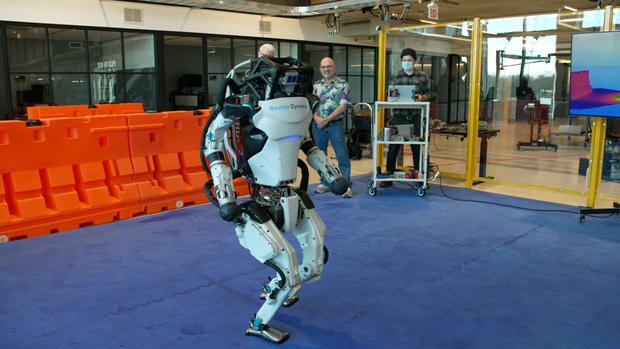
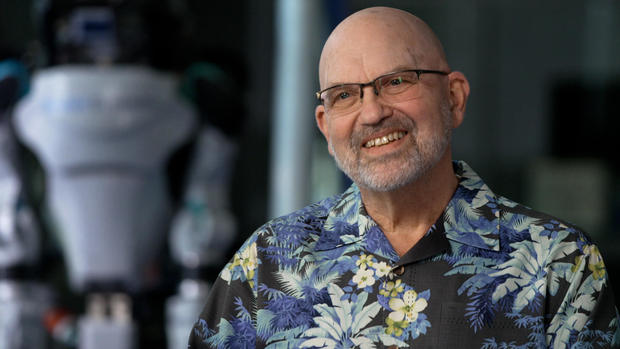
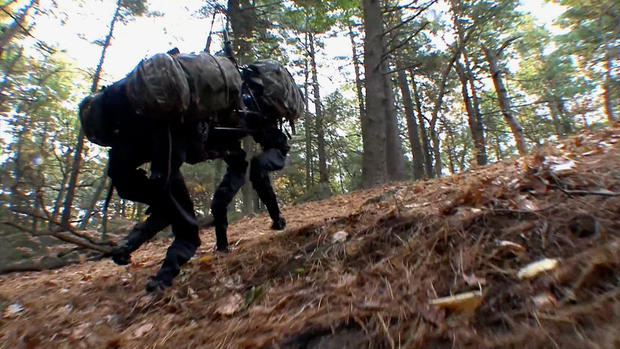
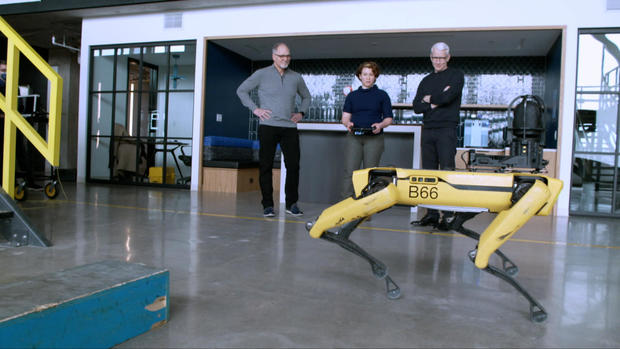
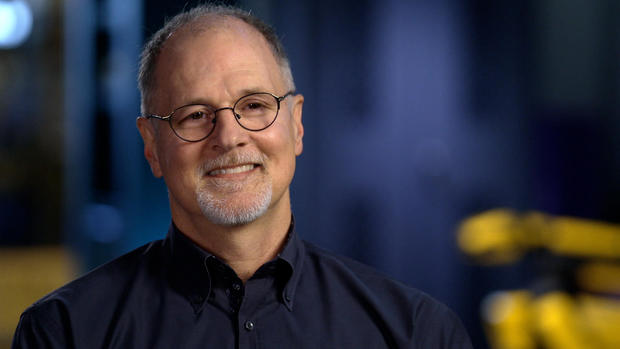
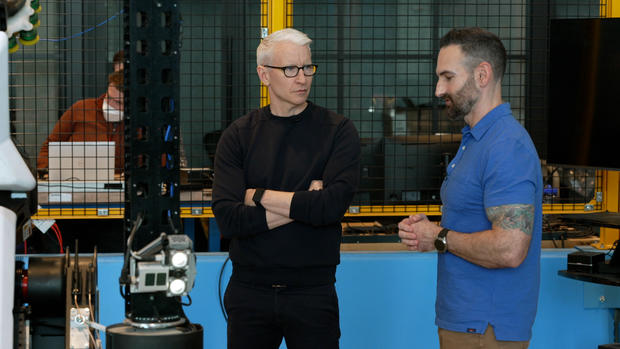














0 Response to "Boston Dynamics: Inside the workshop where robots of the future are being built - 60 Minutes - CBS News"
Post a Comment